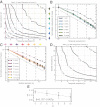Unique in the Crowd: The privacy bounds of human mobility
- PMID: 23524645
- PMCID: PMC3607247
- DOI: 10.1038/srep01376
Unique in the Crowd: The privacy bounds of human mobility
Abstract
We study fifteen months of human mobility data for one and a half million individuals and find that human mobility traces are highly unique. In fact, in a dataset where the location of an individual is specified hourly, and with a spatial resolution equal to that given by the carrier's antennas, four spatio-temporal points are enough to uniquely identify 95% of the individuals. We coarsen the data spatially and temporally to find a formula for the uniqueness of human mobility traces given their resolution and the available outside information. This formula shows that the uniqueness of mobility traces decays approximately as the 1/10 power of their resolution. Hence, even coarse datasets provide little anonymity. These findings represent fundamental constraints to an individual's privacy and have important implications for the design of frameworks and institutions dedicated to protect the privacy of individuals.
Figures




References
-
- Clippinger J. In Rules for Growth: Promoting Innovation and Growth Through Legal Reform (Kauffman Foundation, Kansas City, 2010).
-
- Clanchy M. T. From Memory to Written Records England 1066–1307 (Harvard University Press, Cambridge, 1979).
-
- Warren S. & Brandeis L. The right to privacy. Harvard Law Review 193, 193–220 (1890).
-
- Hey T., Tansley S. & Tolle K. (eds) The Fourth Paradigm: Data-Intensive Scientific Discovery (Microsoft Research, Redmond, 2009).
-
- Barabasi A.-L. The origin of bursts and heavy tails in human dynamics. Nature 435, 207–211 (2005). - PubMed
Publication types
MeSH terms
LinkOut - more resources
Full Text Sources
Other Literature Sources

